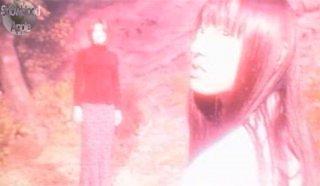
Review
©
Alex Apple, 2002. |
|||||||||||||||||
Directed by Shunichi Nagasaki, 100 min. starring Yui Natsukawa, Michitaka Tsutsui, Chiaki Kuriyama, Toshie Negishi, Ren Osugi, Makoto Satô, Taro Suwa, and Tomoko Otakara.
Not really fitting into this site's "Asian Extreme Cinema" catagorisation, Shikoku nevertheless is quite a well-crafted if somewhat anodyne ghost story which first saw the light of day touring as a B feature with Ring 2. And, to be frank, it does share a fair number of similarities with that movie, not least a raven-haired female figure with astonishing psychic powers, recently returned from the dead... But, if you're expecting another Sadako, move along, there's nothing to see here. On the other hand, a more convenient reference point might be one of the West's more traditional religious horror films based deep in Catholic mythology, such as perhaps The Exorcist or The Omen. For, while Shikoku in no way can hold a candle to those two movies, it's based most carefully in Buddhist practice; the pilgrimage to the 88 temples of Shikoku. This is the Japanese equivalent of the trip to Mecca in Islam or perhaps a Christian visit to the holy land; every practitioner is almost expected to make the 1,000 mile round-trip during at least one point in their lives. It emulates the journey of Kukai the Daishi in the 8th century, and involves visiting 88 temples on the island of Shikoku, in order to get rid of all "evil passions". The traditional dress is a staff and a white and a white suit - also, it must be said, the traditional dressing for corpses. Indeed, when the temples were less accessible than they are today, the staff came to be the grave marker of those pilgrims who fell during their journey. It should also be noted that the conventional route is clockwise round the island; "But some people deliberately make a counterclockwise circuit as Emon Saburo did until he finally succeeded in meeting the Daishi" according to http://www.kagawa-jc.ac.jp/~steve_mc/shikoku/pilgrimage.html. That last bit is important to this movie.
The movie intially focusses on the childhood relationships between Hinako, Sayori and Fumiya, two girls and a boy who live in Kochi in rural Shikoku. It's established early on that Sayori is able to connect with the dead on some level, and indeed the female members of her Hiura family are usually priestesses of some kind. Hinako accidentally witnesses a seance in which Sayori is channelling a dead boy's voice to his parents - though Sayori swears Hinako to silence. Hinako has to move away to Tokyo as her father has a new job, and this is where the first section of the film ends. The adult Hinako (played by Yui Natsukawa) then returns to Shikoku - quite what for is left unclear; it seems there is a property to be disposed of. Equally she has the intention of catching up with both Sayori and Fumiya. Sayori, in particular, she wrote to but never received any reply from. She visits the Hiura house, but no-one answers the door even though through the frosted upstairs window she can see a figure. In town, she catches up with another old school friend who reveals the truth: Sayori drowned when she was 16 and in high school. When she later meets up with Fumiya (Michitaka Tsutsui), he reveals he and Sayori were seeing each other at the time she died, and that, although her father is in hospital following an accident eight years previously while climbing a mountain, her mother has been on the Shikoku pilgrimage every year since her daughter died. Around this time in Kochi things start to get very odd; a young boy sees the ghost of his deceased grandfather and statues are broken in the graveyard. When Fumiya and Hinako investigate, they find, behind a pair of now-broken but previously locked gates accessing Hiura property, a small pool with a pillar in the middle and with a cave in the cliff to one side. Fumiya reveals to Hinako that he has seen Sayori since she died... and Hinako starts to get suspicious about exactly who it was she saw at the window of the Hiura house.
To this end she goes to visit Mr Hiura in the hospital - he's pretty much comatose, but an odd stain on the ceiling has taken the form of the number sixteen, the age Sayori was when she died. Meanwhile, Fumiya has consulted a spiritual expert, Mr Oda (Taro Suwa), who examines the pool and the cave and declares it to be a gate to the underworld. He also reveals Mr Hiura to be the author of an unpublished book on the history of Shikoku. Rifling through the Hiura house, Fumiya finds the manuscript and in it Hiura reveals that the pilgrimage around the island forms a holy circle, in effect a seal between the mortal world and the land of the dead. But if the seal were somehow to be broken, this barrier would fall, and Shikoku, the land of four islands, would become Shikoku, the land of the dead... Also discovered in the house is a room with the seals of all 88 temples fifteen times over... the number of times the slightly dotty Mrs Hiura (Toshie Negishi) has made the pilgrimage. Only something's not quite right - the seals reveal that Mrs Hiura has been doing the pilgrimage backwards, and is now on her sixteenth rotation. The bewilderment amongst the two of them grows, but not so much as to preclude a 'romantic interlude' that, frankly, seems tacked on, even if it does try to make the point that Fumiya has forgotten any romantic notions about Sayori. Except for the slight problem that Sayori (or at least, her ghost) doesn't seem to feel the same way and in the film's most chilling moment puts her hand on Fumiya's shoulder as he is talking, his back turned, to Hinako. Fumiya thinks of course it's Hinako, except Hinako's in the kitchen watching Sayori (Chiaki Kuriyama) creep up on her new boyfriend. After that little apparition, the two go back to Mr Oda with their new information and he sends them to a full-time pilgrim, Sento Naoro (Makoto Satô), who has dedicated his life to keeping the Shikoku seal intact. It's his considered opinion that Mrs Hiura is trying to break the seal, and that, as Sayori was sixteen when she died, a completion of the sixteenth reverse pilgrimage will do so...
Like I said a little earlier, if you're looking for chills and jump-scenes you've come looking in the wrong place. Shikoku is a beautifully shot and lit supernatural drama, but lacks pace and a sense of dread. Indeed, at the end, you get the feeling that Nagasaki wanted to show the landscape more than any sense of characterisation or plot development. Indeed, the plot is very wishy-washy, and lacks much coherence. Many of the actors seemed to have phoned their performances in - Michitaka Tsutsui is unconvincing as the male lead and is just, well, there. And, to be honest, Toshie Negishi's Mrs Hiura is so damn overblown that it's difficult to take her at all seriously during any of her screen time. There's no empathy for the main characters, although the more sappy amongst you might find (as indeed the director probably intended) yourselves empathising with Sayori at the film's conclusion. That said, the conclusion has a totally baffling act by Fumiya, just like Yoshimi at the end of Dark Water, one that seems to totally contrary to everything that he did and said up until that point. Also, there's an abundance of overbearingly sappy piano music running throughout the entire film that does nothing to add to any unsettling atmosphere at all. Maybe from Western eyes, one that are unfamiliar with Buddhist ritual and belief, Shikoku is ineffective because the background is not there. However, even with some understanding of Buddhist practice, this film still doesn't work on a "horror" level. If, on the other hand, you approach it more as a romance, or mystery, or human drama, it works much better. The problem is, of course, that that isn't what the director probably had in mind...
Snowblood
Apple Rating for this film: |
|||||||||||||||||
text,
webdesign (c) 2002 M. Apple. All characters, situations and images
remain the property of their respective owners. The
text and webdesign of this site may not be copied, reproduced, mirrored,
printed commercially or ripped off in any other way. Do not hotlink
directly to images hosted on this site. |
|||||||||||||||||






















